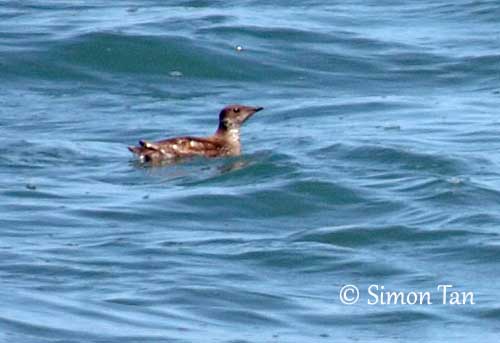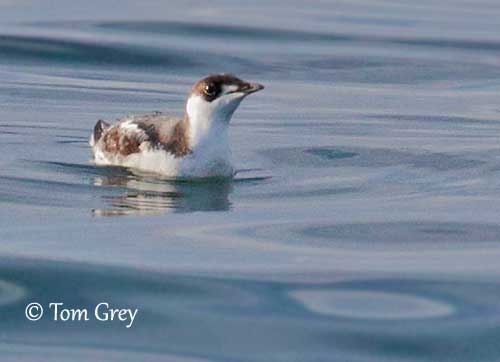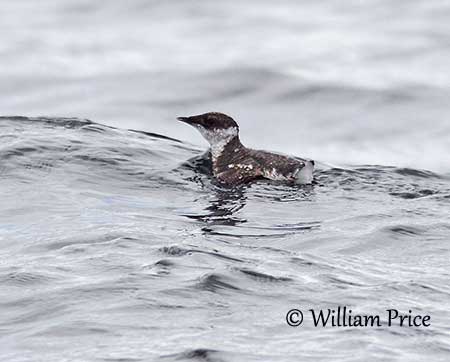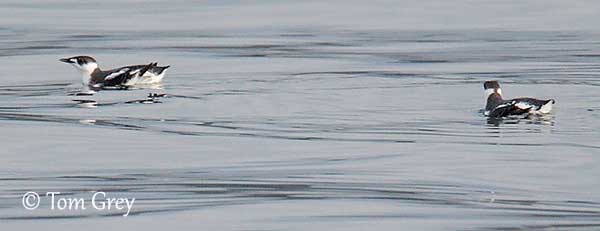
Fr: Guillemot marbré
Ang: Marbled Murrelet
All: Marmelalk
Esp: Mérgulo jaspeado americano
Ita: Urietta marmorizzata
Nd: Marmeralk
Sd: Marmoralka
Photographers:
Tom Grey
Tom Grey's Bird Pictures & Tom Grey's Bird Pictures 2
William Price
PBase-tereksandpiper & Flickr William Price
Simon Tan
PBase Bird galleries
Text by Nicole Bouglouan
Sources:
HANDBOOK OF THE BIRDS OF THE WORLD Vol 3 by Josep del Hoyo-Andrew Elliott-Jordi Sargatal - Lynx Edicions - ISBN : 8487334202
FIELD GUIDE TO THE BIRDS OF NORTH AMERICA - National Geographic Society - ISBN: 0792274512
All About Birds (Cornell Lab of Ornithology)
Animal Diversity Web (University of Michigan Museum of Zoology)
Bird Web (Seattle Audubon Society)
Wikipedia, the free encyclopaedia
Alaska Department of Fish and Game
Oregon Fish and Wildlife Office
Marbled Murrelet
Brachyramphus marmoratus
Charadriiformes Order – Alcidae Family
INTRODUCTION:
The Marbled Murrelet and the Kittlitz’s Murrelet are included in the fourth group in the family Alcidae. These small species are darkish brown in summer with scaled or barred pattern, and more typically blackish and white in winter. They are restricted to the Pacific.
The Marbled Murrelet is almost exclusively fish-eater, and forages below the sea surface, in coastal marine waters and inland saltwater, occasionally on freshwater lakes. Unlike most Alcidae species, it does not nest in colonies but usually far inland. It nests high above the ground, on tree branches in coniferous forests.
The Marbled Murrelet is threatened by logging involving the loss of its nesting habitat. The population is declining due to the usual threats both at sea and on land. It is evaluated as Endangered.
DESCRIPTION OF THE BIRD:
Biometrics:
Length: 24-26 cm
Weight: 120-270 g
The Marbled Murrelet in breeding plumage has dark brown back, wings, tail and top of head.
On the underparts, throat, breast and belly are brown with white and cinnamon speckles. The bird appears “marbled” giving the species its name.
The blackish bill is slender and pointed. The eyes are blackish brown. Legs and webbed feet are flesh-coloured with dark webs.
Male and female are similar.

The Marbled Murrelet in winter plumage has blackish upperparts and top of head, and white underparts. We can see a white band extending from cheeks to around the nape, and a white scapular patch.
The immature resembles adult in winter, but it is finely streaked dark on the white underparts that become uniformly white by first winter.
RANGE:
The Marbled Murrelet breeds in W Aleutians to Barren islands and SE Alaska, S to C California.
It winters offshore and along coasts near the breeding grounds or somewhat South.
HABITAT:
The Marbled Murrelet breeds in mature or old-growth coniferous forest, usually near the coastline, but also considerable distances inland, up to 75 kilometres from the ocean, and up to 1300 metres of elevation.
It nests in trees, on thick limb covered with moss, high above the ground, but also on steep slopes and rock cavities on the ground according to nest-site availability.
It forages in the ocean, in coastal waters, bays and inland saltwater. It usually feeds up to 500 metres offshore.
During winter, it is found in the same type of habitat and frequents mature coniferous forests where it can roost, displays and searches for nesting-sites.
CALLS AND SONGS: SOUNDS BY XENO-CANTO
The Marbled Murrelet is highly vocal. The typical call is a high-pitched “keer-keer” used as contact call between individuals. This call is mainly heard at dawn and dusk, while flying to and from the nest. Other sounds such as whistles and groans and some others are given at nest-site, in flight or at sea.
Sounds created by the wings during the flight can be heard while the bird is flying over and through the canopy of forests where it nests.

BEHAVIOUR IN THE WILD:
The Marbled Murrelet forages in fairly shallow waters and sometimes in lakes near the coast. It feeds on fish and crustaceans, but the diet may vary according to season and range. The main preys are small sand lance, capelin and herring. The crustaceans usually include shrimps of genus Euphausia, mysids and amphipods.
The preys are swallowed underwater, except those carried to the nest.
The Marbled Murrelet swims underwater, propelled by its muscular wings used as flippers. The small webbed feet are used for steering. It is very agile and moves rapidly underwater. The dive lasts less than 30 seconds.
Thanks to its dense waterproof plumage, this species is well-adapted to the cold N Pacific waters. It may feed in mixed-species flocks too.
The breeding behaviour of this species is poorly known. The Marbled Murrelet is probably monogamous with long-term pair-bonds. It does not nest in colonies, but mostly as isolated or scattered pairs in coniferous forests. Both mates are more vocal during the breeding season.
The Marbled Murrelet performs seasonal post-breeding movements, but it usually winters relatively near of the breeding sites. They often move to inshore waters and may form large flocks.
It performs a zigzag flight over the water with rapid wingbeats on stubby wings. This flight action makes it similar to an oversized bumblebee.

REPRODUCTION OF THIS SPECIES:
The breeding season is longer than in other species. It takes place from late March to late August in N America, between mid-April and mid-September in California, and from mid-June to late August in Alaska.
The Marbled Murrelet breeds solitary or at low density in mature forests. In the northern part of the range, the nest is often on the ground on mountainside, whereas in the southern part, it is often placed on large tree branch in dense forest. The nest-site is often far from the ocean, up to 75 kilometres inland.
The nest is very simple, a shallow, mossy depression on horizontal branch near the trunk, or on the ground (but rarely).
The female lays a single large egg, variably tinged yellowish, olive or blue-green with darker markings. Both adults share the incubation during about one month, with stints of 24 hours. The chick is fed by its parents and leaves the nest 27-28 days after hatching. It is usually able to perform sustained flight before to leave the nest. The first flight takes it directly to the sea, or to a lake along the route. At sea, it joins other murrelets and starts to forage for food. It can breed at 2-3 years old.

PROTECTION / THREATS / STATUS:
The Marbled Murrelet suffers from natural predation on eggs and chicks, and fledglings can be lost during their first flight to the sea if they fall to the forest floor where they perish.
This species is threatened by logging involving the loss of the nesting habitat. Prey availability in Pacific has declined, involving a lower proportion of individuals able to reach the breeding condition. Nest predation by Corvidae in California, fishing nets at sea and oil-spills also cause considerable mortality.
The global population is estimated to number 350,000/420,000 individuals, and is currently still decreasing.
The Marbled Murrelet is evaluated as Endangered.